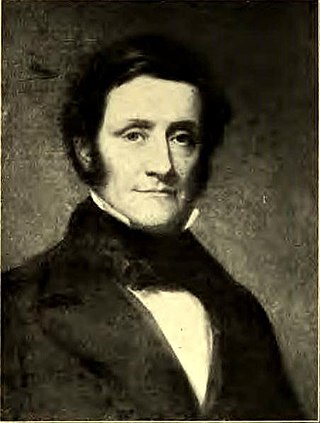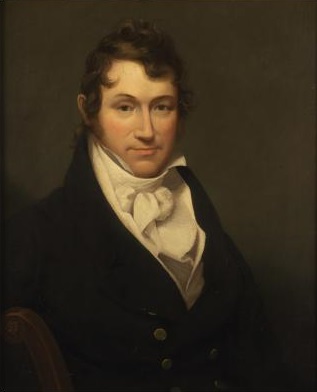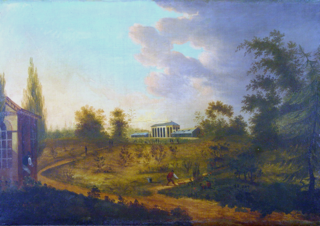
Alexander Hamilton was an American military officer, statesman, and Founding Father who served as the first secretary of the treasury from 1789 to 1795 during George Washington's presidency.

Aaron Burr Jr. was an American politician, businessman, lawyer, and Founding Father who served as the third vice president of the United States from 1801 to 1805 during Thomas Jefferson's first presidential term. He founded the Manhattan Company on September 1, 1799. Burr is remembered for his famous personal and political conflict with Alexander Hamilton, which culminated in the Burr–Hamilton duel in Weehawken, New Jersey on July 11, 1804. Burr mortally wounded Hamilton, who died from his wounds the following day.

Benjamin Moore was the second Episcopal bishop of New York and the fifth President of Columbia University. He is remembered for having given Holy Communion to Alexander Hamilton on his deathbed, and for being the father of Clement Clarke Moore, the reputed author of the 1823 Christmas poem "A Visit From St. Nicholas."

The Burr–Hamilton duel took place in Weehawken, New Jersey, between Aaron Burr, the third and current U.S. vice president at the time, and Alexander Hamilton, the first and former Secretary of the Treasury, at dawn on July 11, 1804. The duel was the culmination of a bitter rivalry that had developed over years between both men, who were high-profile politicians in the newly-established United States, founded following the victorious American Revolution and its associated Revolutionary War.
Hosack's Folly is a 2005 historical novel written by Australian author Gillen D'Arcy Wood. Based on the life of renowned New York physician Dr. David Hosack, the story takes place in 1820s Manhattan during an impending yellow fever epidemic.

William Peter Van Ness was a United States district judge of the United States District Court for the District of New York and the United States District Court for the Southern District of New York, also notable for serving as Aaron Burr's second in Burr's duel with Alexander Hamilton.
John Franklin Gray was an American educator and physician, a pioneer in the field of homoeopathy and one of its first practitioners in the United States. He is also recognized as an important medical reformer.

Geneva Medical College was founded on September 15, 1834, in Geneva, New York, as a separate department (college) of Geneva College, currently known as Hobart and William Smith Colleges. In 1871, the medical school was transferred to Syracuse University in Syracuse, New York.

John Kearny Rodgers was an American surgeon who was known for his skill in both ophthalmic and vascular surgery. He was the co-founder of the New York Eye Infirmary and a Fellow and Trustee of the New York College of Physicians and Surgeons.

William Coleman was the first editor of The New York Evening Post, which is now the New York Post. He was chosen for the position by Alexander Hamilton, who founded the newspaper in 1801.

The history of Columbia University began before it was founded in 1754 in New York City as King's College, by royal charter of King George II of Great Britain. It is the oldest institution of higher learning in the state of New York, and the fifth oldest in the United States.
Henry George Kunkel was an American immunologist, known for his discoveries in basic immunology research, especially his contribution to the development of clinical immunology. He has been referred to as "the father of immunopathology."
George I. Eacker was a New York lawyer. He is best known for having fatally shot Philip Hamilton, the eldest son of Alexander Hamilton and Elizabeth Schuyler Hamilton, in a duel on November 23, 1801, in Weehawken, New Jersey.
Philip Hamilton was the eldest child of Alexander Hamilton and Elizabeth Schuyler Hamilton. He died at age 19, fatally shot in a duel with George Eacker.

Joanne B. Freeman is a U.S. historian and tenured Professor of History and American Studies at Yale University. Having researched Alexander Hamilton both independently and collaboratively with mentors and peers for more than forty years, she is regarded as a leading expert on his life and legacy. Freeman has published two books as well as articles and op-eds in newspapers including The New York Times, magazines such as The Atlantic and Slate and numerous academic journals referencing the U.S. Founding Father. In addition to her many public lectures on Hamilton, outside of her regular student curriculum at Yale, her talks on the topics of political partisanship and violence in the pre-Civil War Congress have appeared on C-SPAN. In 2005 she was rated one of the "Top Young Historians" in the U.S.

The Elgin Botanic Garden was the first public botanical garden in the United States, established in 1801 by New York physician David Hosack. By 1810, Hosack was no longer able to fund the garden's expenses, and sold the land to the State of New York. The property was given to Columbia College in 1814, and the gardens were abandoned. In the 1920s, it became the site of Rockefeller Center.

Stephen Price was a theatrical manager and impresario from New York City who managed the Park Theatre in Manhattan, and Drury Lane in London.
Harold Coffin Syrett was an American historian. He served as the executive editor of The Papers of Alexander Hamilton and as the fourth president of Brooklyn College.
William Bard was a lawyer and pioneer in life insurance who founded the New York Life Insurance and Trust Company.
Dr. Jabez Campfield was a colonial-era doctor, one of the earliest to set up practice in Morristown, New Jersey. He served as a surgeon in the Continental Army during the American Revolutionary War. During the Continental Army's winter encampment in Morristown in 1777, Dr. Campfield helped inoculate soldiers against a smallpox outbreak that spread through the army and the area that winter. Dr. Campfield was a surgeon on the Sullivan Expedition in upstate New York in the summer and autumn of 1779, during which he kept a detailed diary which has been preserved and published. During the winter encampment of 1779-1780, surgeon general Dr. John Cochran stayed in Dr. Campfield's home, and his home served as a "flying hospital". Dr. Cochran's niece, Elizabeth Schuyler, came to stay in Dr. Campfield's home, and while there fell in love and became engaged to Founding Father Alexander Hamilton.


















